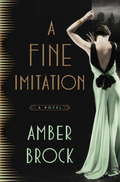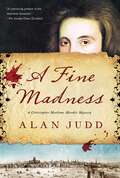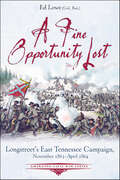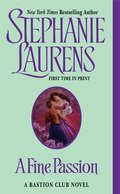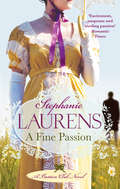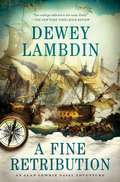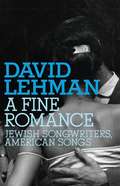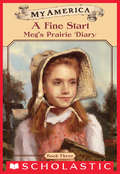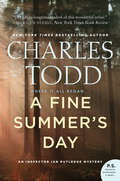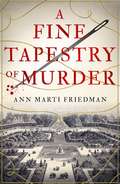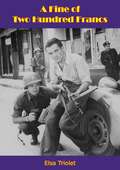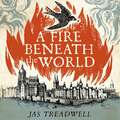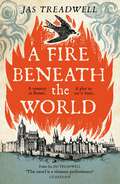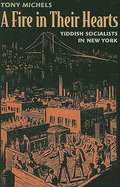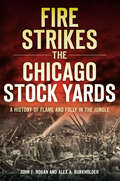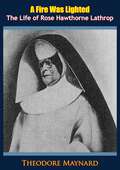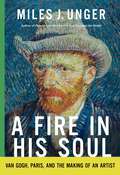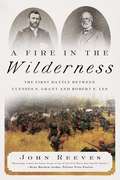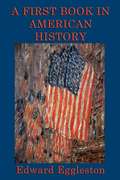- Table View
- List View
A Fine Imitation: A Novel
by Amber BrockSet in the glamorous 1920s, A Fine Imitation is an intoxicating debut that sweeps readers into a privileged Manhattan socialite's restless life and the affair with a mysterious painter that upends her world, flashing back to her years at Vassar and the friendship that brought her to the brink of ruin.Vera Bellington has beauty, pedigree, and a penthouse at The Angelus--the most coveted address on Park Avenue. But behind the sparkling social whirl, Vera is living a life of quiet desperation. Her days are an unbroken loop of empty, champagne-soaked socializing, while her nights are silent and cold, spent waiting alone in her cavernous apartment for a husband who seldom comes home. Then Emil Hallan arrives at The Angelus to paint a mural above its glittering subterranean pool. The handsome French artist moves into the building, shrouds his work in secrecy, and piques Vera's curiosity, especially when the painter keeps dodging questions about his past. Is he the man he claims to be? Even as she finds herself increasingly drawn to Hallan's warmth and passion, Vera can't suppress her suspicions. After all, she has plenty of secrets, too--and some of them involve art forgers like her bold, artistically talented former friend, Bea, who years ago, at Vassar, brought Vera to the brink of catastrophe and social exile. When the dangerous mysteries of Emil's past are revealed, Vera faces an impossible choice--whether to cling to her familiar world of privilege and propriety or to risk her future with the enigmatic man who has taken her heart. A Fine Imitation explores what happens when we realize that the life we've always led is not the life we want to have.From the Hardcover edition.
A Fine Madness: A Christopher Marlowe Murder Mystery
by Alan JuddA captivating espionage novel that explores the life of theatrical genius—and spy—Christopher Marlowe, whose violent death remains one of the most fascinating mysteries of the Elizabethan Age.In Elizabethan England, the queen&’s chief spymaster, Francis Walsingham, and his team of agents must maintain the highest levels of vigilance to ward off Catholic plots and an ever-present threat of invasion from Spain. One agent in particular—a young Cambridge undergraduate of humble origins, controversial beliefs, and literary genius who goes by the name of Kit Marlowe—is relentless in his pursuit of intelligence for the Crown. When he is killed outside an inn in Deptford, his mysterious death becomes the subject of rumor and suspicion that are never satisfactorily resolved. Years later, when Thomas Phelippes, a former colleague of Marlowe&’s, finds himself imprisoned in the Tower of London, there is one thing that might give him his freedom back. He must give the king every detail he is able to recall about his murdered friend&’s life—and death. But why is King James so fascinated about Kit Marlowe—and does Phelippes know enough to secure his own redemption?
A Fine Opportunity Lost: Longstreet’s East Tennessee Campaign, November 1863–April 1864 (Emerging Civil War Series)
by Ed LoweIn Old Warhorse vs. Redemption Seeker, the clash between James Longstreet and Ambrose Burnside unfolds in the Western Theater, shaping the fate of East Tennessee and Chattanooga during the Civil War. For James Longstreet, the transfer to the Western Theater in 1863 offered opportunity. For his opponent Ambrose Burnside, the hope of redemption. Longstreet, who Robert E. Lee called his “Old Warhorse,” had long labored in the shadow of both his army commander and the late Thomas J. “Stonewall” Jackson. When Confederate fortunes took a turn for the worse in Tennessee, both Jefferson Davis and Robert E. Lee dispatched Longstreet and most of his First Corps to reinforce Braxton Bragg’s ill-starred Army of Tennessee. Within hours of his arrival Longstreet helped win the decisive victory at Chickamauga and drove the Union Army of the Cumberland back into Chattanooga. For a host of reasons, some military and some political, Bragg dispatched Longstreet and his troops to East Tennessee. Waiting for him there was Ambrose Burnside, whose early-war success melted away with his disastrous loss at Fredericksburg in late 1862 at the head of the Army of the Potomac, followed by the humiliation of “The Mud March.” Burnside was shuffled to the backwater theater of East Tennessee. Bragg’s investment in Chattanooga and subsequent arrival of Longstreet opened the door to Tennessee’s Union-leaning eastern counties and imperiled Burnside’s isolated force around Knoxville, the region’s most important city. A heavy Confederate presence threatened political turmoil for Federal forces and could cut off Burnside’s ability to reinforce Chattanooga. Longstreet finally had the opportunity to display his tactical and operational skills. The two old foes from the Virginia theater found themselves transplanted to unfamiliar ground The fate of East Tennessee, Chattanooga, and the reputations of the respective commanders, hung in the balance.
A Fine Passion (Bastion Club #5)
by Stephanie LaurensThe men of the Bastion Club are powerful, loyal, and not averse to overcoming danger if they must. Now, after years of loyal service to the Crown, they each -- one by one -- must face that greatest danger of all ...love. The last of his line, Jack, Baron Warnefleet, has fled London after nearly being compromised into marrying a dreadful female. Turning his back on the entire notion of marriage, he rides home to the estate he has not seen for years, determined to set in motion an alternative course of action. But then in the lane before his gate, Jack rescues a startlingly beautiful lady from a menacing, unmanageable horse. However, while he begins by taking command, the lady continues by taking it back. Lady Clarice Altwood is no meek and mild miss. She is the very antithesis of the woolly-headed young ladies Jack has rejected as not for him. Clarice is delectably attractive, beyond eligible, undeniably capable, and completely unforgettable. Why on earth is she rusticating in the country? That enigma is compounded by mystery, and it's quickly clear that Clarice is in danger. Jack must use every ounce of his cunning and wit to protect this highly independent and richly passionate woman ... who has so quickly stolen his heart.
A Fine Passion: Number 4 in series (Bastion Club #4)
by Stephanie LaurensThe last of his line, Jack, Baron Warnefleet, flees London after nearly being compromised into marrying a dreadful female. Turning his back on marriage, he rides home to the estate he has not seen for yearsOutside his gate, however, Jack rescues a lady from an unmanageable horse. But Lady Clarice Altwood is no meek and mild miss. She is delectably attractive, undeniably capable and completely unforgettable. It quickly becomes clear that Clarice is in danger and Jack must use every ounce of his cunning to protect this richly passionate woman...who has so quickly stolen his heart.
A Fine Retribution: An Alan Lewrie Naval Adventure
by Dewey LambdinDewey Lambdin, the reigning master of maritime fiction, continues the adventures of Alan Lewrie, Royal Navy, from his days as a midshipman to captain of his own ship and, though on somewhat dubious grounds, a baronetcy in the 23rd book in the Alan Lewrie series, A Fine Retribution.Captain Alan Lewrie and his small squadron defeat four French frigates off northern Spain, winning honor, glory, and renown. So, why is such a successful captain suddenly without a ship, or another active commission? Why do rumors swirl that jealous foes’ powerful patrons are blighting his career?Months on end ashore, even in entertaining London setting up a household for himself and his retinue, getting his portrait painted, put him in serious sulks. Well, the artist is the sister of one of his midshipmen, a delightful and talented young lady of a modern outlook, but not modern enough to become Lewrie’s lover. Dare he risk a second marriage? Then, just when things are the rosiest, at last, Admiralty calls upon him to develop and command a plan to raid French-held coasts, not with sailors and Marines from his own ship, but with a battalion of Army troops carried in a squadron of transports. It’s intriguing, novel, and a way back to sea, but…can he part from the desirable Jessica Chenery? And if Lewrie does, will his foes allow him to succeed? Be certain that Alan Lewrie will prevail, scruples be damned!
A Fine Romance: Jewish Songwriters, American Songs
by David LehmanWith a poet's eye for language and nuance, Lehman takes a personal journey into the past of American music, showing how the songs that we view as quintessentially American were almost all written by Jews, many of them immigrants. Recounting the stories behind numerous songs and shows, the author explains how Jewish songsmiths combined their native plaintiveness and wit with Black blues to create a distinctively American musical form. With analytical skill, wit, and exuberance, Lehman helps readers understand how natural it is that Wizard of Oz composer Harold Arlen was the son of a cantor who incorporated "Over the Rainbow" into his Sabbath liturgy Annotation c2010 Book News, Inc. , Portland, OR (booknews. com)
A Fine Start: A Fine Start (My America)
by Kate McMullanIn her third and final diary, by Kate McMullan, Meg continues to face the hardships of life on the prairie with her brave and sweet spirit.Meg continues to describe the daily realities on the prairie as she and her family make their lives in Kansas. Throughout these times of difficulty and joy, Meg is always courageous and thoughtful.
A Fine Summer's Day
by Charles ToddOn a fine summer's day in June 1914, Ian Rutledge is planning to propose to a woman he deeply loves, despite hints from his family and friends that she may not be the most suitable choice for a policeman's wife. To the north, another man in love--a Scottish Highlander named Hamish MacLeod--asks his own sweetheart to marry him.Back in England, a son grieves for his mother, dredging up a dark injustice that will trigger a series of murders that Rutledge must solve. The victims are all upstanding and well-liked. The local police have their suspicions about the culprits and are less than cooperative with the London detective.As clouds of war gather on the horizon, Rutledge digs deeper, finding similarities and patterns between the murders. With every moment at stake, he sets out to right a terrible wrong--an odyssey that will eventually force him to choose between the Yard and his country, between love and duty, and between honor and truth. stake, Rutledge sets out to right a wrong--an odyssey that will eventually force him to choose between the Yard and his country, between love and duty, and between honor and truth.
A Fine Tapestry of Murder
by Ann Marti FriedmanA compelling historical murder mystery set amongst the artists in seventeenth-century Paris. For fans of C.J. Sansom and S.J. Parris. 'A rich and achingly beautiful novel' - Carol McGrath (author of the Daughters of Hastings trilogy) on An Artist in Her Own Right. Paris, 1676. When a body washes up on the banks of the Bièvre river, a young woman finds herself embroiled in an intricate murder case.At first it seems mere coincidence that the dead man was discovered outside the Royal Manufactory of the Gobelins, home to a community of artists and craftsmen. He was not one of them, after all. But Anne-Marie, a sculptor's wife, soon realises that the victim may well be known within the walls of the Gobelins - and that the killer might be amongst them.With the police apparently disinterested, it is a mystery that is hers alone to solve. Anne-Marie's investigations will take her from the unsavoury slums of the Ile Notre-Dame to the grand ducal residences of the Place Royale. But who can she truly trust on the streets of Paris?Readers LOVED An Artist in Her Own Right:'A wonderful blend of fact and fiction that I literally read in two sittings''Alive with action and colour''The ebb and flow of relationships, between family members and artists, are beautifully conceived and nuanced''Wonderful imaginative detail'
A Fine Tapestry of Murder
by Ann Marti FriedmanA compelling historical murder mystery set amongst the artists in seventeenth-century Paris. For fans of C.J. Sansom and S.J. Parris. 'A rich and achingly beautiful novel' - Carol McGrath (author of the Daughters of Hastings trilogy) on An Artist in Her Own Right. Paris, 1676. When a body washes up on the banks of the Bièvre river, a young woman finds herself embroiled in an intricate murder case.At first it seems mere coincidence that the dead man was discovered outside the Royal Manufactory of the Gobelins, home to a community of artists and craftsmen. He was not one of them, after all. But Anne-Marie, a sculptor's wife, soon realises that the victim may well be known within the walls of the Gobelins - and that the killer might be amongst them.With the police apparently disinterested, it is a mystery that is hers alone to solve. Anne-Marie's investigations will take her from the unsavoury slums of the Ile Notre-Dame to the grand ducal residences of the Place Royale. But who can she truly trust on the streets of Paris?Readers LOVED An Artist in Her Own Right:'A wonderful blend of fact and fiction that I literally read in two sittings''Alive with action and colour''The ebb and flow of relationships, between family members and artists, are beautifully conceived and nuanced''Wonderful imaginative detail'
A Fine of Two Hundred Francs
by Elsa Triolet‘You or I would walk barefoot in the snow to save an unknown comrade from death. We have learned to kill...the traitors’It is the winter of 1942. Juliette Noël moves silently through Occupied France, trudging across the snowy countryside, working for the Resistance, always just one move ahead of the Gestapo. The painter Alexis Slavsky must conceal his Jewish blood. As he drifts-from Montparnasse to Lyons to the Alps—the precariousness of his Bohemian life becomes intensified by the exigencies of war. Russian-born Louise has survived Nazi interrogation and escaped from a concentration camp. Now she lies low in a ‘safe’ house, waiting to rejoin the maquis.First published illegally by Underground presses, these extraordinary stories of the French Resistance are a moving and shocking testament to the courage of those caught up by the nightmare of war.
A Fire Beneath the World
by James TreadwellGod has abandoned the world.Perfect for fans of Susanna Clarke and Andrew Taylor!A country in flames.1791. The age of belief and superstition is passing. A new light dawns. In Paris, revolution threatens to set the world ablaze.But whose hand stokes the fire?Across the sea in England, Thomas Peach lives in quiet retirement. Some call him a magician, others a madman. But when his friend the poetess Arabella Farthingay falls prey to a sinister seducer, Mr Peach's fading powers are called on once more.He follows her to France - and into a world where reason contends with terror, brotherhood with bloodshed, and the last remnants of faith with the oldest enemy of them all...Praise for Jas Treadwell:'Treadwell's book is a magnificent pastiche of 18th-century fiction'The Sunday Times'Tristram Shandy meets Jonathan Strange & Mr Norrell in a novel that addresses dark disturbing themes with tremendous wit, charm and elegance'Daily Express'Part historical pastiche, part gothic horror, this is an ambitious and stylistically bold 18th-century adventure with shades of Jonathan Strange & Mr Norrell'SFX'Treadwell's book entertains and impresses . . . He must be heartily congratulated both for performing an extraordinary feat of literary ventriloquism and also for reminding us what historical fiction does best: create an entirely convincing vanished world while also using that world as a lens through which to view the present day'Guardian
A Fire Beneath the World
by James TreadwellGod has abandoned the world.Perfect for fans of Susanna Clarke and Andrew Taylor!A country in flames.1791. The age of belief and superstition is passing. A new light dawns. In Paris, revolution threatens to set the world ablaze.But whose hand stokes the fire?Across the sea in England, Thomas Peach lives in quiet retirement. Some call him a magician, others a madman. But when his friend the poetess Arabella Farthingay falls prey to a sinister seducer, Mr Peach's fading powers are called on once more.He follows her to France - and into a world where reason contends with terror, brotherhood with bloodshed, and the last remnants of faith with the oldest enemy of them all...Praise for Jas Treadwell:'Treadwell's book is a magnificent pastiche of 18th-century fiction'The Sunday Times'Tristram Shandy meets Jonathan Strange & Mr Norrell in a novel that addresses dark disturbing themes with tremendous wit, charm and elegance'Daily Express'Part historical pastiche, part gothic horror, this is an ambitious and stylistically bold 18th-century adventure with shades of Jonathan Strange & Mr Norrell'SFX'Treadwell's book entertains and impresses . . . He must be heartily congratulated both for performing an extraordinary feat of literary ventriloquism and also for reminding us what historical fiction does best: create an entirely convincing vanished world while also using that world as a lens through which to view the present day'Guardian
A Fire Beneath the World
by James TreadwellGod has abandoned the world.Perfect for fans of Susanna Clarke and Andrew Taylor!A country in flames.1791. The age of belief and superstition is passing. A new light dawns. In Paris, revolution threatens to set the world ablaze.But whose hand stokes the fire?Across the sea in England, Thomas Peach lives in quiet retirement. Some call him a magician, others a madman. But when his friend the poetess Arabella Farthingay falls prey to a sinister seducer, Mr Peach's fading powers are called on once more.He follows her to France - and into a world where reason contends with terror, brotherhood with bloodshed, and the last remnants of faith with the oldest enemy of them all...Praise for Jas Treadwell:'Treadwell's book is a magnificent pastiche of 18th-century fiction'The Sunday Times'Tristram Shandy meets Jonathan Strange & Mr Norrell in a novel that addresses dark disturbing themes with tremendous wit, charm and elegance'Daily Express'Part historical pastiche, part gothic horror, this is an ambitious and stylistically bold 18th-century adventure with shades of Jonathan Strange & Mr Norrell'SFX'Treadwell's book entertains and impresses . . . He must be heartily congratulated both for performing an extraordinary feat of literary ventriloquism and also for reminding us what historical fiction does best: create an entirely convincing vanished world while also using that world as a lens through which to view the present day'Guardian
A Fire Burns in Kotsk: A Tale of Hasidism in the Kingdom of Poland
by Glenn Dynner Menashe Unger Jonathan BoyarinHalf a century after Hasidism blossomed in Eastern Europe, its members were making deep inroads into the institutional structure of Polish Jewish communities, but some devotees believed that the movement had drifted away from its revolutionary ideals. Menashe Unger's A Fire Burns in Kotsk dramatizes this moment of division among Polish Hasidim in a historical account that reads like a novel, though the book was never billed as such. Originally published in Buenos Aires in 1949 and translated for the first time from Yiddish by Jonathan Boyarin, this volume captures an important period in the evolution of the Hasidic movement, and is itself a missing link to Hasidic oral traditions. A non-observant journalist who had grown up as the son of a prominent Hasidic rabbi, Unger incorporates stories that were told by his family into his historical account. A Fire Burns in Kotsk begins with a threat to the new, rebellious movement within Hasidism known as "the school of Pshiskhe," led by the good-humored Reb Simkhe Bunim. When Bunim is succeeded by the fiery and forbidding Rebbe of Kotsk, Menachem Mendl Morgenstern, the new leader's disdain for the vast majority of his followers will lead to a crisis in his court. Around this core narrative of reform and crisis in Hasidic leadership, Unger offers a rich account of the everyday Hasidic court life--filled with plenty of alcohol, stolen geese, and wives pleading with their husbands to come back home. Unger's volume reflects a period when Eastern European Jewish immigrants enjoyed reading about Hasidic culture in Yiddish articles and books, even as they themselves were rapidly assimilating into American culture. Historians of literature, Polish culture, and Jewish studies will welcome this lively translation.
A Fire In Their Hearts: Yiddish Socialists In New York
by Tony MichelsIn a compelling history of the Jewish community in New York during four decades of mass immigration, Tony Michels examines the defining role of the Yiddish socialist movement in the American Jewish experience. <p><p> The movement, founded in the 1880s, was dominated by Russian-speaking intellectuals, including Abraham Cahan, Mikhail Zametkin, and Chaim Zhitlovsky. Socialist leaders quickly found Yiddish essential to convey their message to the Jewish immigrant community, and they developed a remarkable public culture through lectures and social events, workers' education societies, Yiddish schools, and a press that found its strongest voice in the mass-circulation newspaper Forverts. <p> Arguing against the view that socialism and Yiddish culture arrived as Old World holdovers, Michels demonstrates that they arose in New York in response to local conditions and thrived not despite Americanization, but because of it. And the influence of the movement swirled far beyond the Lower East Side, to a transnational culture in which individuals, ideas, and institutions crossed the Atlantic. New York Jews, in the beginning, exported Yiddish socialism to Russia, not the other way around. <p> The Yiddish socialist movement shaped Jewish communities across the United States well into the twentieth century and left an important political legacy that extends to the rise of neoconservatism. A story of hopeful successes and bitter disappointments, A Fire in Their Hearts brings to vivid life this formative period for American Jews and the American left.
A Fire Strikes the Chicago Stock Yards: A History of Flame and Folly in the Jungle (Disaster Ser.)
by Alex A. Burkholder John F HoganThis compelling history chronicles some of the most intense and tragic fires in Chicago&’s storied meatpacking district.Chicago&’s Union Stock Yards made the city &“the hog butcher of the world,&” but the notoriety came at a grievous cost. From their opening on Christmas Day of 1865 to their final closure in July of 1971, The Yards were the site of nearly three hundred extra-alarm fires. That infamous history includes some of the most disastrous conflagrations of a city famous for fire. In 1910, twenty-one firemen and three civilians were killed in a blaze at a beef warehouse—the largest death toll for an organized fire department in the nation prior to 9/11. The meatpackers who ran the yards considered the constant threat of fire as part of the cost of doing business, shrugging it off with an, &“It&’s all right, we're fully covered.&” For the firefighters who were forced to plunge into the flames again and again, it was an entirely different matter.
A Fire Was Lighted: The Life of Rose Hawthorne Lathrop
by Theodore MaynardRose Hawthorne Lathrop, the daughter of Nathaniel Hawthorne, was the foundress of the Dominican Sisters of Hawthorne. Her religious name was Mother Mary Alphonsa.“Rose Hawthorne (1851-1926) was born in Lenox, Massachusetts. She was the daughter of American author Nathaniel Hawthorne (1804-1864), who was known for the probing psychological aspects of his writing derived from his Puritan upbringing. In 1871, Rose married editor George Parsons Lathrop. Sadly, their only child died at the age of five in 1881. A writer in her own right, Rose published Along the Shore, a book of poems, in 1888. In 1891, Rose, along with her husband, converted to Roman Catholicism.In 1895, Rose formally separated from George, who died in 1897. Rose then embarked on a career nursing people afflicted with cancer. In 1899, she established St. Rose’s Free Home for Incurable Cancer, in New York City. Rose became a Catholic nun and founded the Dominican Congregation of St. Rose of Lima, later changed to the Servants of Relief for Incurable Cancer. Rose’s religious name was Alphonsa. In 1901, she opened Rosary Hill Home in Hawthorne, New York, a town named after her.”-Georgetown.
A Fire in His Soul: Van Gogh, Paris, and the Making of an Artist
by Miles J. UngerThe fascinating story of Vincent van Gogh&’s two groundbreaking years in Paris, where he transformed himself from a provincial unknown into one of the world&’s great visionary artists.Vincent Van Gogh arrived in the French capital on the last day of February 1886, a month short of his thirty-third birthday. He was a man beaten down by life, half-starved, and nearly broken psychologically. He was saved by his brother Theo, who provided him with room, board, and, most crucially, emotional support while he attempted to master the difficult craft of painting. Thus far, Vincent's crude scenes of peasant life rendered in murky shades of brown and gray were both hackneyed and amateurish. Theo, a successful art dealer at a prestigious Parisian firm, dismissed them as gloomy, unappealing, and, worst of all, unmarketable. By the time Vincent left Paris, almost exactly two years later, he&’d transformed himself into one of the most original artists of the age, turning out works of hallucinatory intensity in vivid hues and stamped with his own distinctive personality. A Fire in His Soul chronicles this remarkable transformation. It&’s a tale filled with tragedy and triumph, personal anguish and creative fulfillment, as Vincent, through sheer force of will, reinvents himself as a painter of unparalleled expressive power. Along the way, the reader will discover an unfamiliar Van Gogh: not the solitary genius of the popular imagination, shunned by an uncomprehending world and conjuring masterpieces from the depths of his lonely soul. In Paris, he was at the center of a community of like-minded seekers. Here, Van Gogh was able to engage in a lively dialogue with fellow artists almost as daring as he was, expanding his notion of what art could and should be. It was in the cafes and studios of Montmartre and in the grand galleries of the Louvre and Luxembourg, that Van Gogh received his artistic education—a crash course that at first disoriented him but ultimately sparked his creative breakthrough. Working alongside such legendary figures as Gauguin, Toulouse-Lautrec, Seurat, and Signac, he found his voice and launched an artistic revolution.
A Fire in Zion: The Israeli-Palestinian Search for Peace
by Mark PerryAttempts to reach peace between Israel and the Palestinians.
A Fire in the Wilderness: The First Battle Between Ulysses S. Grant and Robert E. Lee
by John ReevesThe riveting account of the first bloody showdown between Ulysses S. Grant and Robert E. Lee—a battle that sealed the fate of the Confederacy and changed the course of American history. In the spring of 1864, President Lincoln feared that he might not be able to save the Union. The Army of the Potomac had performed poorly over the previous two years, and many Northerners were understandably critical of the war effort. Lincoln assumed he&’d lose the November election, and he firmly believed a Democratic successor would seek peace immediately, spelling an end to the Union. A Fire in the Wilderness tells the story of that perilous time when the future of the United States depended on the Union Army&’s success in a desolate forest roughly sixty-five miles from the nation&’s capital. At the outset of the Battle of the Wilderness, General Lee&’s Army of Northern Virginia remained capable of defeating the Army of the Potomac. But two days of relentless fighting in dense Virginia woods, Robert E. Lee was never again able to launch offensive operations against Grant&’s army. Lee, who faced tremendous difficulties replacing fallen soldiers, lost 11,125 men—or 17% of his entire force. On the opposing side, the Union suffered 17,666 casualties. The alarming casualties do not begin to convey the horror of this battle, one of the most gruesome in American history. The impenetrable forest and gunfire smoke made it impossible to view the enemy. Officers couldn&’t even see their own men during the fighting. The incessant gunfire caused the woods to catch fire, resulting in hundreds of men burning to death. &“It was as though Christian men had turned to fiends, and hell itself had usurped the place of the earth,&” wrote one officer. When the fighting finally subsided during the late evening of the second day, the usually stoical Grant threw himself down on his cot and cried.
A First Book of American History
by Edward EgglestonContinuing the biographical approach to teaching history found in his Stories of Great Americans for Little Americans, Eggleston draws a more in-depth picture of the development of the United States using the stories of the living and breathing Americans who made it all happen.
A First Class Murder (First Lady #9)
by Elliott RooseveltMrs. Eleanor Roosevelt is on her way back to the U.S. aboard the great liner Normandie, when a Russian Ambassador collapses and dies, the victim of strychnine poisoning. Mrs. Roosevelt tries to help identify the murderer.
A First Class Temperament: The Emergence of Franklin Roosevelt, 1905-1928
by Geoffrey C. WardIn this classic of American biography, based upon thousands of original documents, many never previously published, the prize-winning historian Geoffrey C. Ward tells the dramatic story of Franklin Roosevelt's unlikely rise from cloistered youth to the brink of the presidency with a richness of detail and vivid sense of time, place, and personality usually found only in fiction.<P> In these pages, FDR comes alive as a fond but absent father and an often unfeeling husband--the story of Eleanor Roosevelt's struggle to build a life independent of him is chronicled in full-as well as a charming but pampered patrician trying to find his way in the sweaty world of everyday politics and all-too willing willing to abandon allies and jettison principle if he thinks it will help him move up the political ladder. But somehow he also finds within himself the courage and resourcefulness to come back from a paralysis that would have crushed a less resilient man and then go on to meet and master the two gravest crises of his time.<P> This is a sequel to Before the Trumpet: Young Franklin Roosevelt, 1882-1905
